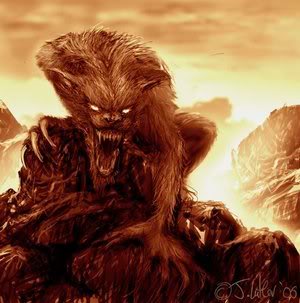|

|
A werewolf or werwolf, also known as a lycanthrope (from
the Greek λυκάνθρωπος: λύκος, lukos, "wolf", and άνθρωπος,
anthrōpos, man), is a mythological or folkloric human with the ability to shapeshift into a wolf or an anthropomorphic
wolf-like creature, either purposely, by being bitten or scratched by another
werewolf, or after being placed under a curse. This transformation is often associated with the
appearance of the full moon, as
popularly noted by the medieval chronicler Gervase of Tilbury, and perhaps in earlier
times among the ancient Greeks through
the writings of Petronius.
Werewolves are often attributed super-human strength and senses, far beyond
those of both wolves or men. The werewolf is generally held as a European character, although its lore spread through the
world in later times. Shape-shifters, similar to werewolves, are common in tales
from all over the world, most notably amongst the Native Americans, though
most of them involve animal forms other than wolves. The word werewolf is thought to derive from Old English
wer (or were)— and wulf. The first part, wer, translates
as "man" (in the specific sense of male human, not the race of humanity
generally). It has cognates in several Germanic languages including Gothic wair, Old High German
wer, and Old Norse
verr, as well as in other Indo-European languages, such as Sanskrit 'vira', Latin vir, Irish fear, Lithuanian
vyras, and Welsh gŵr, which have the same meaning.
The second half, wulf, is the ancestor of modern English "wolf"; in some cases it also had
the general meaning "beast."
An alternative etymology
derives the first part from Old English weri (to wear); the
full form in this case would be glossed
as wearer of wolf skin. Related to this interpretation is Old
Norse ulfhednar, which denoted lupine equivalents of
the berserker, said to wear
a bearskin in battle.
Yet other sources derive the word from warg-wolf, where warg
(or later werg and wero) is cognate with Old Norse vargr,
meaning "rogue," "outlaw," or, euphemistically, "wolf".
A
Vargulf was the kind of wolf that slaughtered many members of a flock or
herd but ate little of the kill. This was a serious problem for herders, who had
to somehow destroy the rogue wolf before it destroyed the entire flock or herd.
The term Warg was used in Old English
for this kind of wolf. Possibly related is the fact that, in Norse society, an
outlaw (who could be murdered with no legal repercussions and was forbidden to
receive aid) was typically called vargr, or "wolf." Many authors have speculated that werewolf and vampire legends may have been used to explain serial killings in less
rational ages. This theory is given credence by the tendency of some modern
serial killers to indulge in practices commonly associated with werewolves, such
as cannibalism, mutilation, and cyclic attacks. The idea is well explored in Sabine
Baring-Gould's work The Book of Werewolves.
Until the 20th century, wolf attacks on humans were an
occasional, but widespread feature of life in Europe. Some scholars
have suggested that it was inevitable that wolves, being the most feared
predators in Europe, were projected into the folklore of evil shapeshifters.
This is said to be corroborated by the fact that areas devoid of wolves
typically use different kinds of predator to fill the niche; werehyenas in Africa,
weretigers in India, as well as
werepumas ("runa uturunco") and werejaguars ("yaguaraté-abá" or "tigre-capiango")
of southern South America.
In his Man into
Wolf (1948), anthropologist Robert Eisler drew attention to the fact that
many Indo-European tribal names and some modern European surnames mean "wolf" or
"wolf-men". This is argued by Eisler to indicate that the European transition
from fruit gathering to predatory hunting was a conscious process,
simultaneously accompanied by an emotional upheaval still remembered in
humanity's subconscious, which in turn became reflected in the later medieval
superstition of werewolves.
Some modern researchers have tried to explain the reports of werewolf
behaviour with recognised medical conditions. Dr Lee Illis of Guy's Hospital in
London wrote a paper in 1963 entitled On Porphyria and the Aetiology of
Werewolves, in which he argues that historical accounts on werewolves could
have in fact been referring to victims of congenital porphyria, stating how the symptoms of photosensitivity,
reddish teeth and psychosis could
have been grounds for accusing a sufferer of being a werewolf. This
is however argued against by Woodward, who points out how mythological
werewolves were almost invariably portrayed as resembling true wolves, and that
their human forms were rarely physically conspicuous as porphyria victims. Others have
pointed out the possibility of historical werewolves having been sufferers of hypertrichosis, a
hereditary condition manifesting itself in excessive hair growth. However,
Woodward dismissed the possibility, as the rarity of the disease ruled it out
from happening on a large scale, as werewolf cases were in medieval Europe.
People
suffering from Downs Syndrome have been suggested by some
scholars to have been possible originators of werewolf myths. Woodward
suggested rabies as the origin of
werewolf beliefs, claiming remarkable similarities between the symptoms of that
disease and some of the legends. Woodward focused on the idea that being bitten
by a werewolf could result in the victim turning into one, which suggested the
idea of a transmittable disease like rabies. However,
the idea that lycanthropy could be transmitted in this way is not part of the
original myths and legends and only appears in relatively recent beliefs.
|
 Copyright(c) 2007
- 2020. All rights reserved. Copyright(c) 2007
- 2020. All rights reserved.
|

![]() Copyright(c) 2007
- 2020. All rights reserved.
Copyright(c) 2007
- 2020. All rights reserved.